Anisotropic Tensile and Compressive Strengths of Al-4wt.%Cu Alloy Powder: Part 2—Effect of Dendritic Arm Spacings
Abstract
1. Introduction
2. Materials and Methods
2.1. Powder, Compaction and Sintering
2.2. Mechanical, Microstructural and Phase Characterizations
3. Results and Discussion
3.1. Powder Size Distribution and Microstructure
3.2. Anisotropic Tensile and Compressive Strengths
3.3. Anisotropic Ratios
4. Conclusions
- It is found that, although distinct microstructural arrays (i.e., dendrite spacings) are obtained as a function of the cooling rates applied, very similar morphologies of the drilled powders are attained. Also, all crystallographic phases identified are very similar for all examined samples. After the compaction and sintering, the identified phases are identical to those in the as-cast condition.
- It is also found that the increase in the compaction pressures of both the UCS (ultimate compressive strength) and UTS (ultimate tensile strength) is also increased. When analyzing the sample compacted at transversal and longitudinal directions, it is evidenced that the UCS and UTS values corresponding with the transverse samples are higher (~1.5×) than the longitudinal samples. When the powders utilized to produce the specimens are separated between finer (~30 μm) and coarser (~150 μm) dendritic spacings, it is revealed that the fine dendritic spacing provides a higher UCS and UTS in both the transverse and longitudinal samples. This induces that the dendritic spacings have also important roles to determine the anisotropic strengths of the samples examined.
- The anisotropic ratio (AR) is determined using the UTS/UCS ratio. Based on the attained AR results, it is found that all examined samples have shown increasing tendencies with the increase in the compaction pressure. This induces that independent of the compaction directions, i.e., longitudinal or transversal, a tendency to become more isotropic with the increase in the compaction pressure is characterized.
- When the UCS per UTS ratios are analyzed, a unique mathematic relation describes this trend ratio (i.e., 69.5 ln(UTS) − 90) involving both the transverse and longitudinal samples. However, it is interestingly observed that when only the samples containing the fine dendrite arm spacings are considered. When the longitudinal and transverse samples with coarser dendritic spacings are examined, the UCS/UTS ratios characterize two distinctive equations to describe the tendencies, which are different from those determined by the samples with finer spacings.
- Considering the anisotropy ratios, independently of coarser or finer arm spacings are considered, the transverse samples have depicted linear increasing trends. On the other hand, in the longitudinal samples considering both coarser and finer arm spacings, nonlinear increasing trends are clearly established. Although it is not possible to determine how much the dendritic spacing overlaps or overestimates the effects of the compaction directions (transverse or longitudinal), the compaction loading and the powder morphology, it is evidenced that they have important roles in the anisotropic strengths. It seems that the effect is combined or conjugated with the compaction direction, which affects significantly the tensile and compressive anisotropic strengths.
- It is also found that at 300 and 400 MPa, excepting the transverse sample with finer arm spacings, all examined samples have the same order of magnitude for the anisotropy degree. Interestingly, at 600 MPa, the anisotropy ratios depict a decreasing sequence: the highest ratio is that of the longitudinal coarser spacing sample, followed by the longitudinal finer spacing sample and the transverse samples with coarser and finer arm spacings. Although there are differences in the UTS and UCS values depending on the microstructural refinement, the same order of magnitude in the UCS is prescribed. Depending on the compaction level intended, planning in the compaction direction can be preprogrammed or vice versa. Based on the fact that the recycled powder particles from the conventional machining, drilling and turning can be considered. With this, environmentally friendly aspects are attained and hazardous stages are also substantially decreased or eliminated.
Author Contributions
Funding
Institutional Review Board Statement
Informed Consent Statement
Data Availability Statement
Acknowledgments
Conflicts of Interest
References
- Bulei, C.; Stojanovic, B.; Utu, D. Developments of discontinuously reinforced aluminium matrix composites: Solving the needs for the matrix. J. Phys. Conf. Ser. 2022, 2212, 012029. [Google Scholar] [CrossRef]
- Soo, V.K.; Peeters, J.; Paraskevas, D.; Compston, P.; Doolan, M.; Duflou, J.R. Sustainable aluminium recycling of end–of–life products: A joining techniques perspective. J. Clean. Prod. 2018, 178, 119–132. [Google Scholar] [CrossRef]
- Rombach, G. Raw material supply by aluminium recycling–Efficiency evaluation and long–term availability. Acta Mater. 2013, 61, 1012–1020. [Google Scholar] [CrossRef]
- Olivieri, G.; Romani, A.; Neri, P. Environmental and economic analysis of aluminium recycling through life cycle assessment. Int. J. Sustain. Dev. World Ecol. 2006, 13, 269–276. [Google Scholar] [CrossRef]
- Thomas, M.P.; Wirtz, A.H. The ecological demand and practice for recycling of aluminium. Resour. Conserv. Recycl. 1994, 10, 193–204. [Google Scholar] [CrossRef]
- Reis, D.A.P.; Couto, A.A.; Domingues, N.I., Jr.; Hirschmann, A.C.O.; Zepka, S.; Moura, N.C. Effect of artificial aging on the mechanical properties of an aerospace aluminum alloy 2024. Defect Diffus. Forum 2012, 326–328, 193–198. [Google Scholar]
- Reddy, T.B.; Karthik, P.; Krishna, G. Mechanical behavior of Al-Cu binary alloy system/Cu particulates reinforced metal-metal composites. Results Eng. 2019, 4, 100046. [Google Scholar] [CrossRef]
- Iswanto, P.T.; Pambekti, A. Heat treatment T4 and T6 effects on mechanical properties in Al-Cu alloy after remelt with different pouring temperatures. Metalurgija 2020, 59, 171–174. [Google Scholar]
- Alexopoulos, N.D.; Velonaki, Z.; Stergiou, C.I.; Kour-koulis, S.K. Effect of ageing on precipitation kinetics, tensile and work hardening behavior of Al-Cu-Mg (2024) alloy. Mater. Sci. Eng. A 2017, 700, 457–467. [Google Scholar] [CrossRef]
- Fernandez Gutiérrez, R.; Sket, F.; Maire, E.; Wilde, F.; Boller, E.; Requena, G. Effect of solution heat treatment on microstructure and damage accumulation in cast Al-Cu alloys. J. Alloys Compd. 2017, 697, 341–352. [Google Scholar] [CrossRef]
- Rivera-Cerezo, H.; Gaona-Tiburcio, C.; Cabral-Miramontes, J.; Bautista-Margulis, R.; Nieves-Mendoza, D.; Maldonado-Bandal, E.; Estupiñan_lopez, F.; Almeraya-Calderón, F. Effect of heat treatment on the electrochemical behavior of AA2055 and AA2024 alloys for aeronautical applications. Metals 2023, 13, 429. [Google Scholar] [CrossRef]
- Quaresma, J.M.V.; Santos, C.A.; Garcia, A. Correlation between unsteady-state solidification conditions, dendrite spacings, and mechanical properties of Al-Cu alloys. Metall. Mater. Trans. A 2000, 31, 3167–3178. [Google Scholar] [CrossRef]
- Seah, K.H.W.; Hemanth, J.; Sharma, S.C. Effect of the cooling rate in the dendrite arm spacing and the ultimate tensile strength of cast iron. J. Mater. Sci. 1998, 33, 23–28. [Google Scholar] [CrossRef]
- Osório, W.R.; Spinelli, J.E.; Ferreira, I.L.; Garcia, A. The roles of macrosegragation and dendritic array spacings on the electrochemical behavior of an Al 4.5 wt% Cu alloy. Electrochim. Acta 2007, 52, 3265–3273. [Google Scholar] [CrossRef]
- Osório, W.R.; Siqueira, C.A.; Santos, C.A.; Garcia, A. The correlaton between electrochemical corrosion resistance and mechanical strength of as-cast Al-Cu and Al-Si alloys. Int. J. Electrochem. Sci. 2011, 6, 6275–6289. [Google Scholar] [CrossRef]
- Rodrigues, A.V.; Kakitani, R.; Silva, C.; Giovanetti, L.; Dias, M.; Henein, H.; Garcia, A.; Cheung, N. Influence of minor additions of Be on the eutectic modification of an Al-33wt.%Cu alloy solidified under transient conditions. Metals 2023, 13, 94. [Google Scholar] [CrossRef]
- Xiao, A.; Lin, Y.; Huang, C.; Cui, X.; Yan, Z.; Du, Z. Effect of electromagnetic forming-het treatment process on mechanical and corrosion properties of 2024 aluminum alloy. J. Mater. Res. Technol. 2023, 23, 1027–1038. [Google Scholar] [CrossRef]
- Galen, S.; Zavaliangos, A. Strength anisotropy in cold compacted ductile and brittle powders. Acta Mater. 2005, 53, 4801–4815. [Google Scholar] [CrossRef]
- Guo, M.X.; Wang, M.P. Effects of particle size, volume fraction, orientation and distribution on the high temperature compression and dynamic recrystallization behaviors of particle-contaning alloys. Mat. Sci. Eng. A 2012, 546, 15–25. [Google Scholar] [CrossRef]
- Satizabal, L.M.; Caurin, H.F.N.; Meyer, Y.A.; Padilha, G.S.; Bortolozo, A.D.; Osório, W.R. Distinct heat treatments and powder size ratios affecting mechanical responses of Al/Si/Cu composites. J. Comp. Mater. 2021, 55, 3589–3605. [Google Scholar] [CrossRef]
- Loidolt, P.; Ulz, M.H.; Khinast, J. Prediction of the anisotropic mechanical properties of compacted powders. Powder Technol. 2019, 345, 589–600. [Google Scholar] [CrossRef]
- Zavaliangos, A.; Bouvard, D. Numerial simulation of anisotropy in sintering due to prior compaction. Met. Powder Rep. 2002, 57, 39. [Google Scholar] [CrossRef]
- Bouvard, D. Densification behaviour of mixtures of hard and soft powders under pressure. Powder Technol. 2000, 111, 231–239. [Google Scholar] [CrossRef]
- Bonatti, R.S.; Bortolozo, A.D.; Baldo, R.F.G.; Osório, W.R. Anisotropic tensile and compressive strengths of Al-4wt.%Cu alloy powder: Part 1—Effects of compaction loads and heat treatments. Metals 2023. [Google Scholar]
- Bonatti, R.S.; Meyer, Y.A.; Padilha, G.S.; Bortolozo, A.D.; Osório, W.R. Silicon content affecting corrosion behavior of Alp/Sip composites in a biodiesel blend. Corrosion 2020, 76, 1109–1121. [Google Scholar] [CrossRef] [PubMed]
- Bonatti, R.S.; Siqueira, R.R.; Padilha, G.S.; Bortolozo, A.D.; Osório, W.R. Distinct Alp/Sip composites affecting its densification and mechanical behavior. J. Alloys Compd. 2018, 757, 434–447. [Google Scholar] [CrossRef]
- Meyer, Y.A.; Bonatti, R.S.; Costa, D.; Bortolozo, A.D.; Osório, W.R. Compaction pressure and Si contente effects in compressive strengths of Al/Si/Cu alloy composites. Mater. Sci. Eng. A 2020, 770, 138547. [Google Scholar] [CrossRef]
- Kuznetsov, M.A.; Il’yashchenko, D.P.; Lavrova, E.V.; Solodsky, S.A.; Podgornyh, O.A.; Verkhoturova, E.V.. Determination of optimal modes for the production of micro range metal powders. Appl. Eng. Lett. 2022, 7, 17–24. [Google Scholar] [CrossRef]
- Espinosa-Méndez, C.; Maquieira, C.P.; Arias, J.T. The impact of ESG performance on the value of family firms: The moderating role of financial constrainsts and agency problems. Sustainability 2023, 15, 6176. [Google Scholar] [CrossRef]
- Rocha, O.L.; Siqueira, C.A.; Garcia, A. Heat flow parameters affecting dendrite spacings during unsteady-state solidfication of Sn-Pb and Al-Cu alloys. Metall. Mater. Trans. A 2003, 34, 995–1006. [Google Scholar] [CrossRef]
- Osório, W.R.; Moutinho, D.J.; Peixoto, L.C.; Ferreira, I.L.; Garcia, A. Macrosegregation and microstructure dendritic array affecting the electrochemical behavior of ternary Al-Cu-Si alloys. Electrochem. Acta 2011, 56, 8412–8421. [Google Scholar] [CrossRef]
- Osório, W.R.; Peixoto, L.C.; Moutinho, D.J.; Gomes, L.G.; Ferreira, I.L.; Garcia, A. Corrosion resistance of directionally solidified Al-6Cu-1Si and Al-8Cu-3Si alloys castings. Mater. Des. 2011, 32, 3832–3837. [Google Scholar] [CrossRef]
- Rodrigues, A.V.; Lima, T.S.; Vida, T.A.; Brito, C.; Garcia, A.; Cheung, N. Microstructure features and mechanical/electrochemical behavior of directionally solidified Al-6wt.%Cu-5wt.%Ni alloy. Trans. Nonf. Met. Soc. China 2021, 31, 1529–1549. [Google Scholar] [CrossRef]
- Osório, W.R.; Spinelli, J.E.; Freire, C.M.A.; Cardona, M.; Garcia, A. The roles of Al2Cu and of dendritic refinement on surface corrosion resistance of hypoeutectic Al-Cu aslloys immersed in H2SO4. J. Alloys Compd. 2007, 443, 87–93. [Google Scholar] [CrossRef]
- Tsao, C.S.; Huang, E.W.; Wen, M.H.; Wen, M.-H.; Kuo, T.-Y.; Jeng, S.-L.; Jeng, U.-S.; Sun, Y.-S. Phase transformation and precipitation of an Al–Cu alloy during non-isothermal heating studied by in situ small-angle and wide-angle scattering. J. Alloys Compd. 2013, 579, 138–146. [Google Scholar] [CrossRef]
- Shin, D.; Shyam, A.; Lee, S.; Yamamoto, Y.; Haynes, J.A. Solute segregation at the Al/h0-Al2Cu interface in Al-Cu alloys. Acta Mater. 2017, 141, 327–340. [Google Scholar] [CrossRef]
- Zhang, Y.; Li, R.; Chen, P.; Li, X.; Liu, Z. Microstructural evolution of Al2Cu phase and mechanical properties of the large-scale Al alloy components under different consecutive manufacturing processes. J. Alloys Compd. 2019, 808, 151634. [Google Scholar] [CrossRef]
- Jonsén, P.; Haggblad, H.A.; Sommer, K. Tensile strength and fracture energy of pressed metal powder by diametral compression test. Powder Technol. 2007, 176, 148–155. [Google Scholar] [CrossRef]
- Gokçe, A.; Findik, F. Mechancial and physical properties of sintered aluminum powders. J. Achiev. Mater. Manuf. Eng. 2008, 30, 157–164. [Google Scholar]
- Cavaliere, P.; Jahantigh, F.; Shabani, A.; Sadeghi, B. Influence of SiO2 nanoparticles on the microstrucutre and mechanical properties of Al matrix nanocomposites frabricated by spark plasma sintering. Compos. Part B 2018, 146, 60–68. [Google Scholar] [CrossRef]
- Yang, H.; Jiang, L.I.N.; Balog, M.; Krizik, P.; Schoenung, J.M. Reinforcement size dependence of load bearing capacity in ultrafine-grained metal matrix composites. Metall. Mater. Trans. 2017, 48, 4385–4392. [Google Scholar] [CrossRef]
- Wu, C.; Ma, K.; Wu, J.; Famh, P.; Luo, G.; Chen, F.; Shen, Q.; Zhang, L.; Schoenung, J.M.; Lavernia, E.J. Influence of particle size and spatial distribution of B4C reinforcement on the microstructure and mechanical behavior of precipitation strengthened Al alloy matrix composites. Mater. Sci. Eng. A 2016, 675, 421–430. [Google Scholar] [CrossRef]
- Arunachalam, R.; Krishnan, P.K. Compressive response of aluminum metal matirx composites. Encycl. Mater. Compos. 2021, 1, 325–343. [Google Scholar] [CrossRef]
- Yang, B.C.; Che, S.F.; Song, H.W.; Zhang, S.H.; Chang, H.P.; Xu, S.W.; Zhu, Z.H.; Li, C.H. Effects of microstructure coarsening and casting pores on the tensile and fatigue properties of cast A356-T6 aluminum alloy: A comparative investigation. Mater. Sci. Eng. A 2022, 857, 144106. [Google Scholar] [CrossRef]


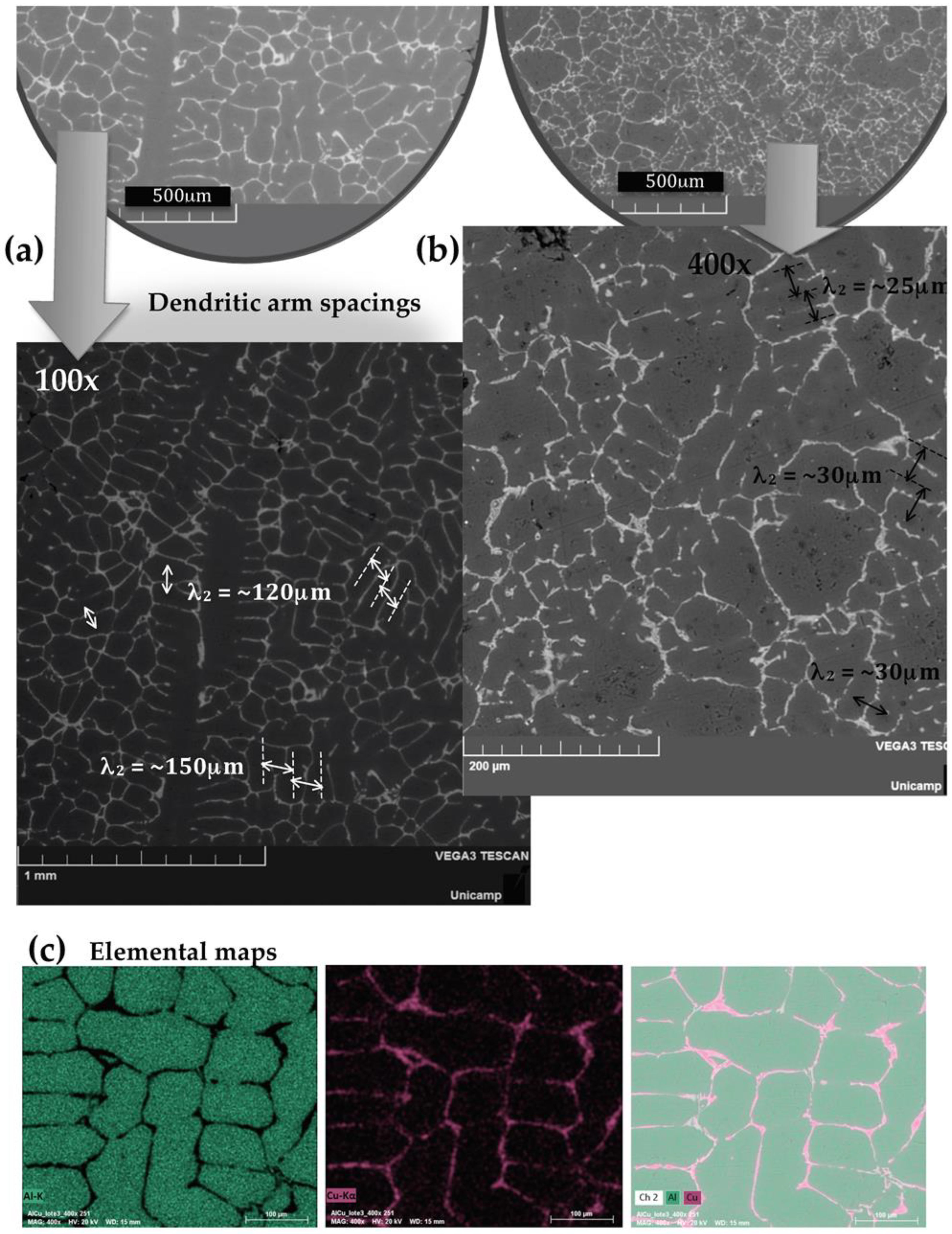
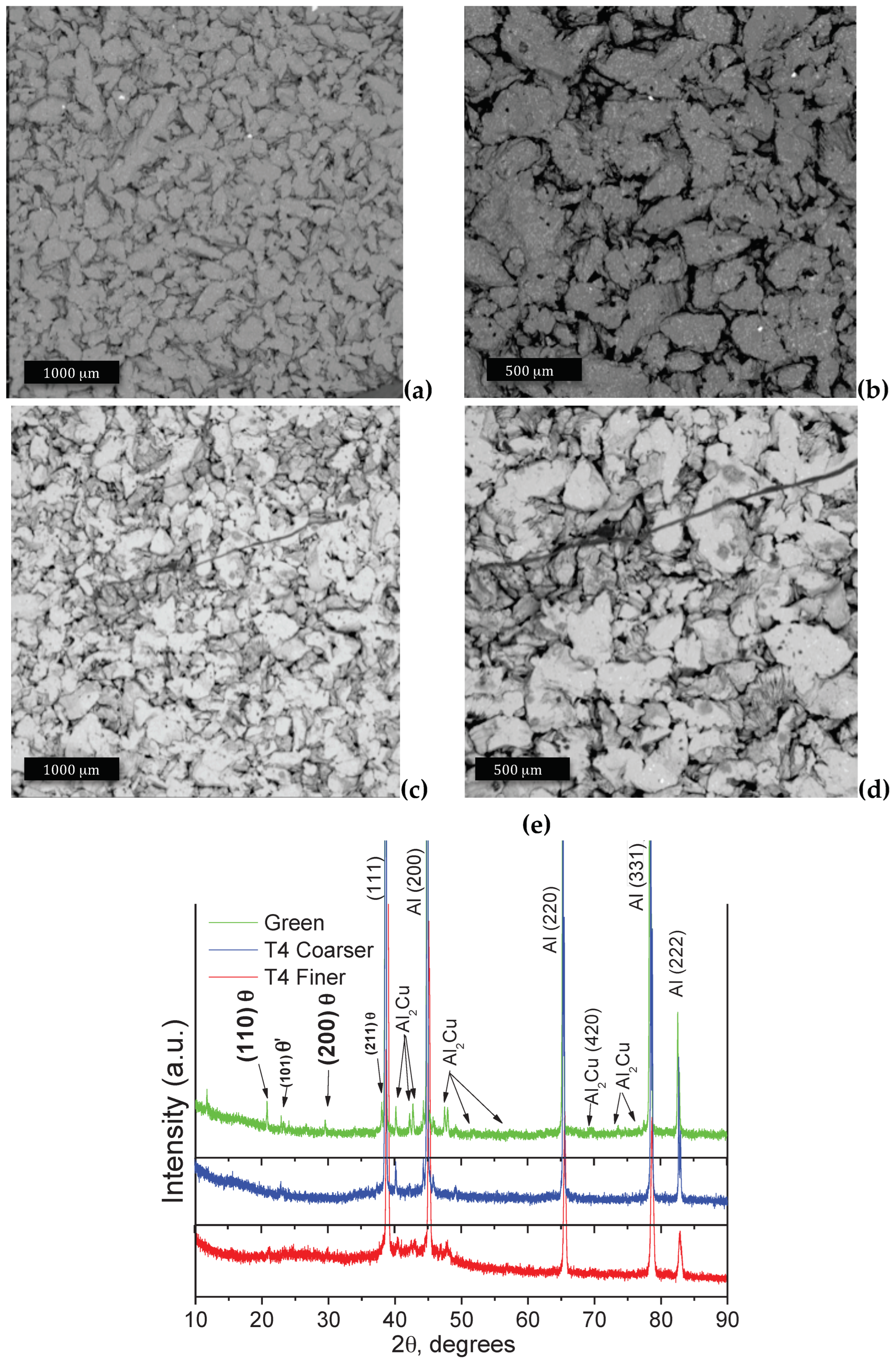

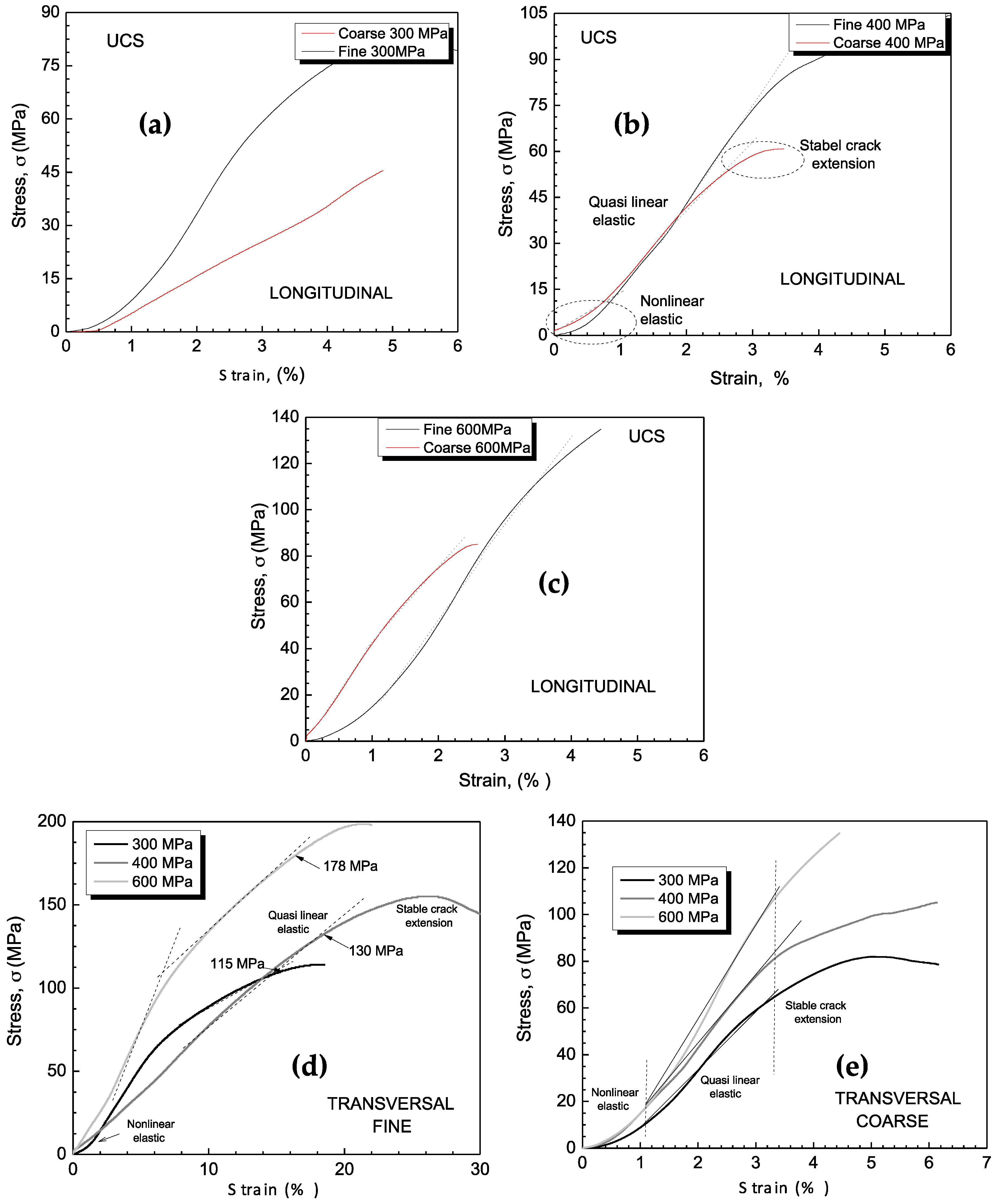
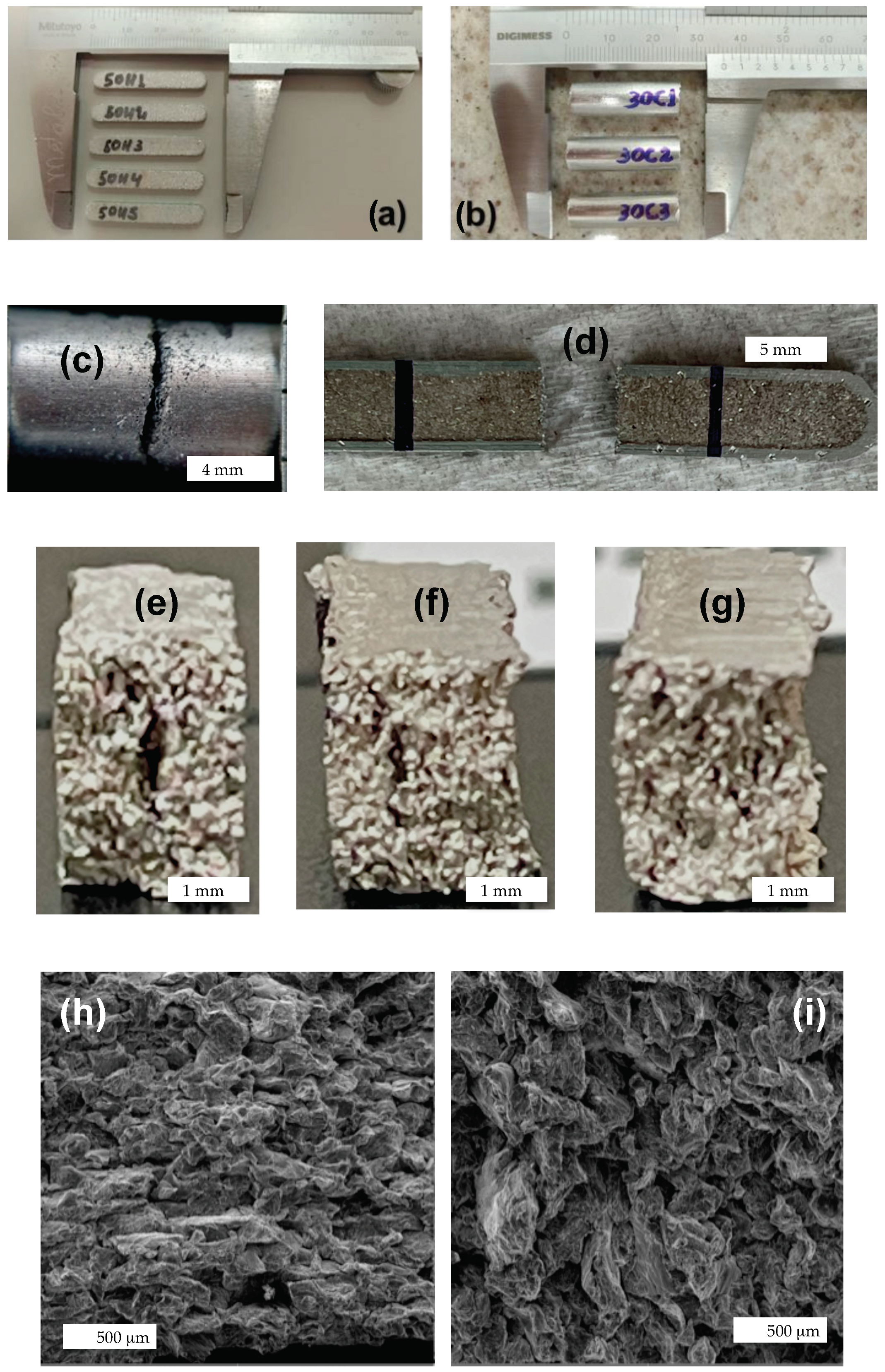
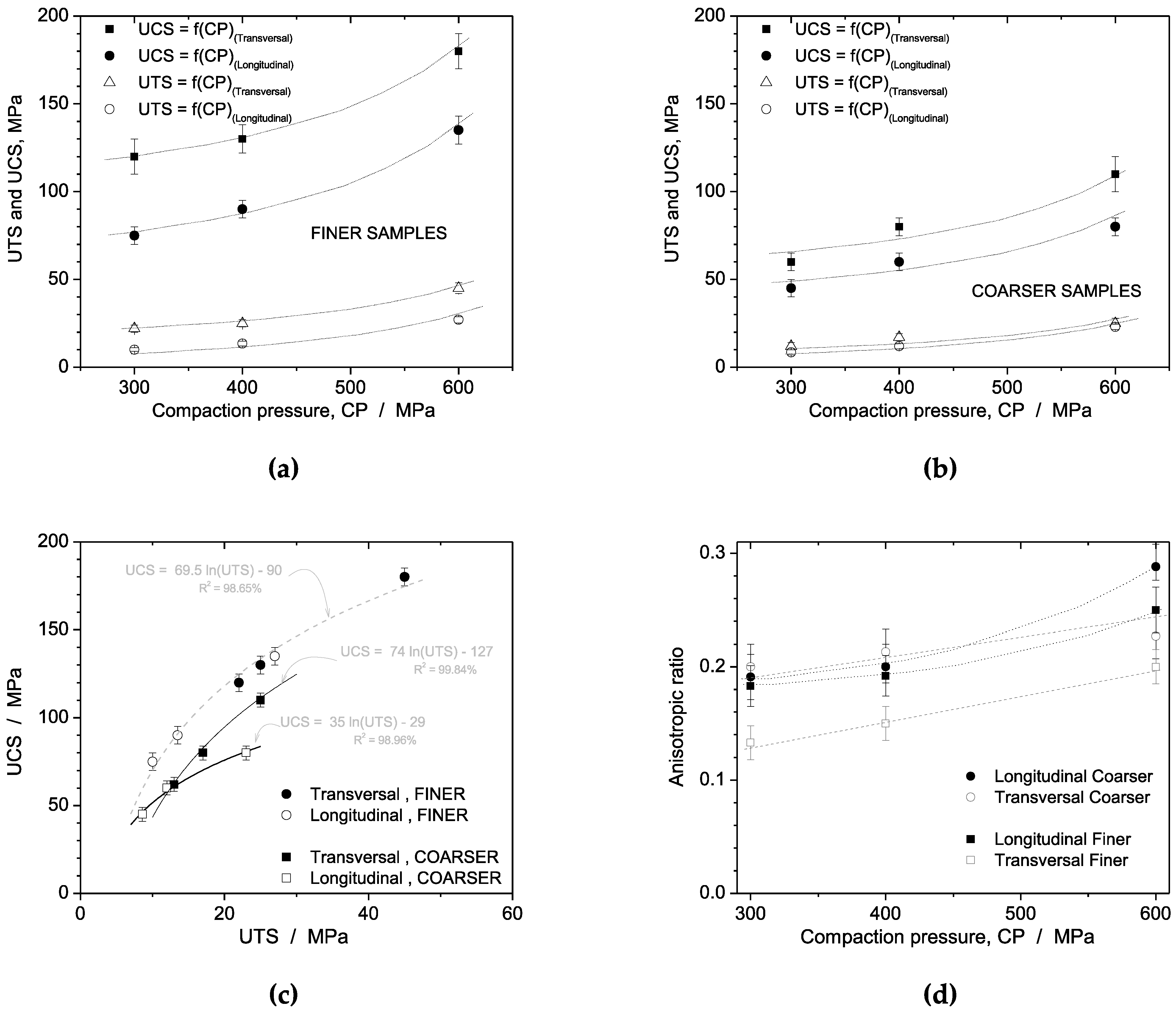
| Compaction Pressure | Dendritic Spacings | Transversal | Longitudinal | ||
|---|---|---|---|---|---|
| UTS (MPa) | ε (%) | UTS (MPa) | ε (%) | ||
| 300 MPa | Fine | 20 (±2) | 5 (±1) | 2.0 (±0.5) | 0.3 (±0.05) |
| Coarse | 13 (±2) | 4 (±1) | 2.5 (±0.5) | 0.5 (±0.05) | |
| 400 MPa | Fine | 25 (±2) | 4 (±1) | 2.8 (±0.3) | 0.3 (±0.05) |
| Coarse | 17 (±2) | 4 (±1) | 2.2 (±0.6) | 0.4 (±0.05) | |
| 600 MPa | Fine | 43 (±3) | 5 (±1) | 3.8 (±0.5) | 1.0 (±0.05) |
| Coarse | 25 (±2) | 6 (±1) | 3.2 (±0.6) | 0.8 (±0.05) | |
| Samples | Finer Spacings | Coarser Spacings | ||||||
|---|---|---|---|---|---|---|---|---|
| Transversal | UCS (MPa) | ε (%) | DC * (MPa) | AR ** | UCS (MPa) | ε (%) | DC * (MPa) | AR ** |
| 300 MPa | 120 (± 10) | 2.0 (± 0.5) | - | 0.183 | 60 (± 5) | 3.5 (± 0.5) | - | 0.200 |
| 400 MPa | 130 (± 8) | 2.2 (± 0.5) | - | 0.192 | 80 (± 5) | 3.0 (± 0.8) | - | 0.213 |
| 600 MPa | 180 (± 10) | 1.6 (± 0.5) | - | 0.250 | 110 (± 8) | 3.0 (± 0.6) | - | 0.227 |
| Longitudinal | UCS (MPa) | ε (%) | DC * (MPa) | AR ** | UCS (MPa) | ε (%) | DC * (MPa) | AR ** |
| 300 MPa | 75 (± 5) | 3.5 (± 0.5) | 10 (± 4) | 0.133 | 45 (± 5) | 3.5 (± 0.5) | 9 (± 3) | 0.191 |
| 400 MPa | 90 (± 5) | 3.0 (± 0.5) | 13.5 (± 0.5) | 0.150 | 60 (± 8) | 2.5 (± 0.5) | 11.5 (± 3) | 0.200 |
| 600 MPa | 135 (± 8) | 3.0 (± 0.5) | 27 (± 3) | 0.200 | 80 (± 10) | 2.0 (± 0.5) | 23 (± 0.8) | 0.288 |
Disclaimer/Publisher’s Note: The statements, opinions and data contained in all publications are solely those of the individual author(s) and contributor(s) and not of MDPI and/or the editor(s). MDPI and/or the editor(s) disclaim responsibility for any injury to people or property resulting from any ideas, methods, instructions or products referred to in the content. |
© 2023 by the authors. Licensee MDPI, Basel, Switzerland. This article is an open access article distributed under the terms and conditions of the Creative Commons Attribution (CC BY) license (https://creativecommons.org/licenses/by/4.0/).
Share and Cite
Bonatti, R.S.; Rodrigues, J.F.Q.; Peixoto, L.C.; Baldo, R.F.G.; Bortolozo, A.D.; Osório, W.R. Anisotropic Tensile and Compressive Strengths of Al-4wt.%Cu Alloy Powder: Part 2—Effect of Dendritic Arm Spacings. Metals 2023, 13, 1282. https://doi.org/10.3390/met13071282
Bonatti RS, Rodrigues JFQ, Peixoto LC, Baldo RFG, Bortolozo AD, Osório WR. Anisotropic Tensile and Compressive Strengths of Al-4wt.%Cu Alloy Powder: Part 2—Effect of Dendritic Arm Spacings. Metals. 2023; 13(7):1282. https://doi.org/10.3390/met13071282
Chicago/Turabian StyleBonatti, Rodrigo S., João F. Q. Rodrigues, Leandro C. Peixoto, Rodrigo F. G. Baldo, Ausdinir D. Bortolozo, and Wislei R. Osório. 2023. "Anisotropic Tensile and Compressive Strengths of Al-4wt.%Cu Alloy Powder: Part 2—Effect of Dendritic Arm Spacings" Metals 13, no. 7: 1282. https://doi.org/10.3390/met13071282
APA StyleBonatti, R. S., Rodrigues, J. F. Q., Peixoto, L. C., Baldo, R. F. G., Bortolozo, A. D., & Osório, W. R. (2023). Anisotropic Tensile and Compressive Strengths of Al-4wt.%Cu Alloy Powder: Part 2—Effect of Dendritic Arm Spacings. Metals, 13(7), 1282. https://doi.org/10.3390/met13071282







